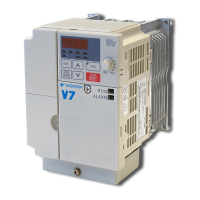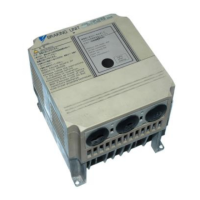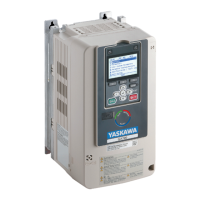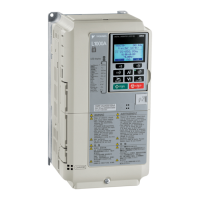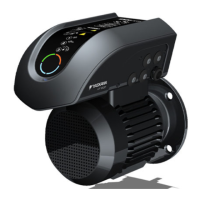1.4 Control Method Type and Corresponding Features
26 YASKAWA SIEPC71061723A YASKAWA AC Drive CR700 Technical Manual
1.4 Control Method Type and Corresponding Features
This drive has 5 available control methods from which to select for different applications. The following table
give information about the features of each control method.
Control Method
V/f Control
(V/f)
Closed Loop V/f Control
(CL-V/f)
Notes
Controlled Motor Induction Motor -
Parameter Settings A1-02 = 0 A1-02 = 1 -
Basic Control V/f
Closed loop V/f control with speed
correction
-
Main Applications
General-purpose variable speed control for
multiple motors in particular (applications
connecting multiple motors to a single
drive)
High-precision speed control with encoders
on machines
-
Encoder Option Card Not necessary Necessary (PG-B3 or PG-X3) -
Maximum Output Frequency 590 Hz 400 Hz -
Speed Control Range 1:40 1:40
Represents the range of variable control. (Keep
increases in motor temperature in mind when
connecting and running motors in this manner.)
Starting Torque 150% / 3 Hz 150% / 3 Hz
This is the motor torque that can be generated at low
speed during startup and the corresponding output
frequency (rotation speed). Drive capacity must be
considered if significant torque is required at low
speed.
Auto-Tuning
Line-to-Line Resistance (usually, not
necessary)
Line-to-Line Resistance (usually, not
necessary)
Automatically tunes electrical motor parameters.
Torque Limits No No
Controls maximum motor torque to protect machines
and loads.
Droop Control No No
Sets load torque slip for motors. Used to distribute
motor loads.
Zero Servo Control No No
Locks servos without an external position controller to
prevent movement caused by external force.
Feed Forward Control No No
Improves speed accuracy when the load changes by
compensating effects of the system inertia.
Overexcitation Deceleration
*1
Yes Yes
Decreases the deceleration time by increasing motor
loss by setting V/f higher than the setting value during
deceleration.
*1 Motor loss increases during overexcitation braking and high-slip braking. Use a maximum braking frequency of 5% ED and a
maximum braking time of 90 s. Use overexcitation braking to decelerate over a shorter time at a pre-determined speed.
Control Method
Open Loop Vector Control
(OLV)
Closed Loop Vector Control
(CLV)
Advanced Open Loop Vector
Control
(AOLV)
Notes
Controlled Motor Induction Motor -
Parameter Settings
A1-02 = 2
(Default)
A1-02 = 3 A1-02 = 4 -
Basic Control
Open Loop Current Vector
Control
Closed Loop Current Vector
Control
Open Loop Current Vector
Control
-
Main Applications
• General-purpose variable speed
control
• Applications that require high-
performance without machine
encoders
Very high-performance control
with motor encoders
Example: High-precision speed
control, torque limits
Sensorless vector control with
speed control
• General-purpose variable speed
control
• Applications that require high-
performance without machine
encoders
-
Encoder Option Card Not necessary Necessary (PG-B3 or PG-X3) Not necessary -
Maximum Output
Frequency
590 Hz 400 Hz 120 Hz -
Speed Control Range 1:200 1:1500 1:200
Represents the range of variable control.
(Keep increases in motor temperature in
mind when connecting and running motors
in this manner.)
Starting Torque 200% / 0.3 Hz
*1
200% / 0 min
-1
*1
200% / 0.3 Hz
*1
This is the motor torque that can be
generated at low speed during startup and
the corresponding output frequency
(rotation speed). Drive capacity must be
considered if significant torque is required
at low speed.
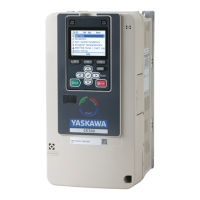
